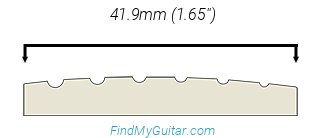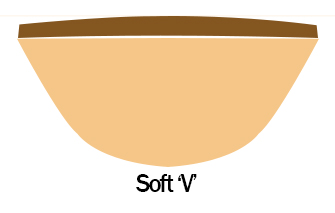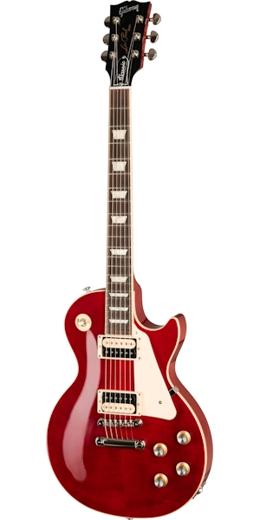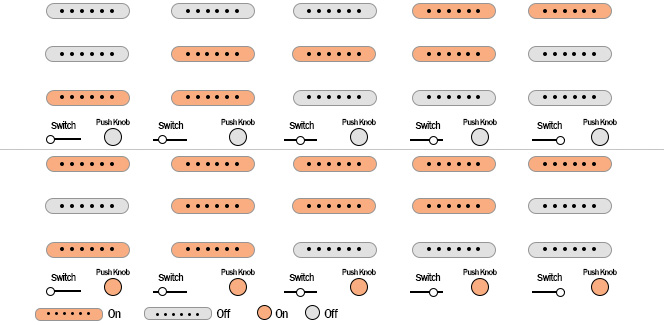Fender JV Modified '60s Stratocaster vs Gibson Les Paul Classic
Reasons to Get
Fender JV Modified '60s Stratocaster over Gibson Les Paul Classic
Reasons to Get
Gibson Les Paul Classic over Fender JV Modified '60s Stratocaster
Other Key Differences
Fender JV Modified '60s Stratocaster vs Gibson Les Paul Classic
Shared Features
Fender JV Modified '60s Stratocaster vs Gibson Les Paul Classic
Common Strengths
- High-Quality Nut
- From a High-Quality-Standards Country
- Top Pickup Brand
Common Weaknesses
- Stays in Tune (Evertune)
- High-Quality Frets
- Compound Radius Fretboard
- Luminescent Sidedots
- Strap Lock
- 21:1 Tuner Ratio
- Active/Passive Preamp
Price History Comparison
These are affiliate links. We may earn a fee if you purchase after clicking. These prices are prone to error. Make sure you're buying the right product after clicking on a link from our site. We are not liable if you buy the wrong product after following these links. As an Amazon Associate site we earn from qualifying purchases.
Which One is Better for Beginners?
The Fender JV Modified '60s Stratocaster meets 7 out of our 8 criteria items for beginner friendliness, while the Gibson Les Paul Classic meets only 4. This takes into account the type of frets, scale length, nut width, bridge type, fretboard radius, and neck profile to determine the easiest combination for new players.
New Player Friendliness
Fender JV Modified '60s Stratocaster- Comfortable shape
- Easy-to-use bridge
- Locking tuners
- Comfortable fretboard
- Tall frets
- Narrow nut
- Comfortable neck
- Short scale
New Player Friendliness
Gibson Les Paul Classic- Comfortable shape
- Easy-to-use bridge
- Tall frets
- Comfortable neck
- Comfortable fretboard
- Narrow nut
- Short scale
- Locking tuners
Nevertheless, when it comes to choosing an instrument, you should pick the one more compatible with your personal style. Still, below we'll try you to give you our results as objectively as it's possible to help you decide.
Sound Quality Comparison
The wood used in an electric guitar or bass is not as important to determine the final tone. However, some people prefer specific wood types, so we'll take a look at those first. Then, we'll take a look at the electronics to determine the versatility and sound quality of each instrument.
Woods Used in the Fender JV Modified '60s Stratocaster


Maple is one of the most popular necks for good reasons. It is a strong wood that is relatively cheap to make and looks beautiful. The highest quality maple is the hardest that comes from North America. Find out more about Maple.
Basswood is a lightweight type of wood that isn't as expensive as other popular choices for guitar building. It gives more power to the mid-range frequencies. Its color can vary from pale white to light brown. Find out more about Basswood.
Woods Used in the Gibson Les Paul Classic


Mahogany is a fairly rare wood nowadays. It's used mostly for bodies due to its relatively lightweight. Gibson popularized it with their Les Paul guitars during their golden years, so this wood has a lot of good reputation behind it. The most expensive type comes from South America and it's still used by Gibson even today. Find out more about Mahogany.
Rosewood is an almost purple-looking wood that is used mainly for fretboards since it's heavy, rare, and expensive. It's sometimes used on acoustic guitar bodies to create stronger warm tones. Find out more about Rosewood.
Winner: Gibson Les Paul Classic.
Pickup Configuration
The Fender JV Modified '60s Stratocaster has an SSS configuration while the Gibson Les Paul Classic has HH pickups.
SSS is perfect for players who like to play clean. The definition you get between notes and the crispiness is unmatched by most other configurations. You can still use it for distortion, but you won't get the same kind of output and power compared to a humbucker, and the hum they produce also makes them less adequate for high gain.
On the other hand, Double Humbucker (HH) is the choice for people who want a fuller, more round sound with tons of mids and lows. Humbuckers also get rid of the hum noise that plague single-coil pickups. They can work out for almost any genre going from Djent to even Jazz.
Pickups Quality
Both come with very good pickups from at least one of the specialized brands in the market. With pickups like these, you probably won't need an upgrade anytime soon.
However, the Fender JV Modified '60s Stratocaster has a slight sound quality advantage when taking into account other factors like the type of pickups, magnet, position, etc.
You can purchase similar pickups to the Fender JV Modified '60s Stratocaster's and use them on any guitar:
Both use Passive pickups. This is what's used for most music genres. They have a regular output and will serve you for both high-gain and clean tones. The alternative (Active pickups) offer a higher output that is mostly used for heavy music.
Winner: Fender JV Modified '60s Stratocaster.
Versatility Comparison
Some instruments offer you more ways to explore your creativity than others. Below you'll find how both compare when it comes to versatility.
Switch Options
The Fender JV Modified '60s Stratocaster gives you 5 switch options while the Gibson Les Paul Classic gives you 3. This means that the Fender JV Modified '60s Stratocaster gives you more options to find the right pickup combination for the type of sound you want to achieve
Both give you different pickup mod options.
The Fender JV Modified '60s Stratocaster offers Parallel Split.
The Parallel Split feature allows it to split and connect some of the pickups in parallel. When wired in parallel, the result is a very bright tone. This is the wire technique used in most Stratocaster guitars, and it's what gives them their signature transparent and clear sound. This is because the pickups' inputs and outputs are wired together, which reduces the signal's travel distance to the output jack.
On the other hand, the Gibson Les Paul Classic comes with the following: Coil Tap, Phase Out.
Coil Tap is similar to Coil Split but it works a bit differently. Instead of completely cancelling one of the coils of the humbucker, it only cuts part of the output once activated. Some people believe this gives the split pickups a more real single-coil sound.
When the Phase Out option is activated, the pickups will ''work against each other'', meaning that they will cancel out their shared frequencies. The result is a very thin sound, instead of a full, rich tone. This is an interesting sound for genres like reggae or funk and has also been used in classic Hard Rock.
When evaluating versatility, we also take into consideration bridge and neck joint type, number of frets, switch options, amount of pickups and more.
Winner: Fender JV Modified '60s Stratocaster.
Final Sound Quality Scores
Build Quality Comparison
When it comes to build quality, we like to take into account everything used to build the instrument. This includes materials, hardware and the quality control expected depending on the country where it was built. Let's see how the Fender JV Modified '60s Stratocaster compares to the Gibson Les Paul Classic.
Country of Origin
The manufacturing country can tell a lot about the build quality of an instrument. The Fender JV Modified '60s Stratocaster is built in Japan while the Gibson Les Paul Classic is made in United States.
Japan has a long history of high-quality guitar building. Little has changed in terms of their manufacturing and quality control over the years. Many guitars made in this country can be compared—and even beat—others made in the US.
The United States is considered one of the best electric guitar manufacturers in the world. A guitar made in this country is supposed to have world-class quality control. Nowadays, guitars made in other countries can beat some of the ones made in the US, but most of the time, this country offers the best you can get. Of course, that comes at a price.
Winner: Tie
Nut Material
If you want your guitar to stay in tune and sound good, you need a well cut nut. Nut quality can be inconsistent even when comparing two copies of the same model. The best way to make sure you're nut will be well done is by getting a nut made by an expert company like TUSQ or Micarta.
The Fender JV Modified '60s Stratocaster has a Bone nut. It's a type of nut found in high-quality instruments. They sound similar to Ivory since they give a lot of sustain and a bright sound (at least when striking open strings). The only problem they can run into is that you may get a bone piece that simply doesn't sound as well as others because that's just how natural materials are.
On the other hand, the Gibson Les Paul Classic comes with a Ivory Tusq nut. Ivory used to be considered the best material for guitar nuts due to its beauty, durability, and the rich harmonics and sustain you could get from a guitar with it. However, the way to obtain it is simply unethical. Enter TUSQ ivory nuts, which are made synthetically to imitate ivory. Technically, it's better than ivory because it is consistent piece-to-piece, while natural materials can vary a lot, even if they're made from the same.
Winner: Tie.
Fret Material
Most fret wire is made of nickel silver. This material eventually wears down after a lot of use and most instruments end up needing a complete fret replacement. However, some expensive models come with stainless steel frets. This is what you should aim for if you can afford it.
Unfortunately, none of them come with stainless steel frets.
Winner: Tie.
Bridge
The perfect bridge for you will depend on your playstyle because they all have advantages and disadvantages. However, some bridges are more expensive—like Floyd Roses and Evertunes—and thus add more value to a guitar.
The Fender JV Modified '60s Stratocaster's brige is a Tremolo. Tremolo bridges give you more versatility than fixed bridges. They let you perform the intense vibrato effects that would be impossible with a fixed bridge. However, since the bridge floats and there's less contact with the body, the strings lose sustain slightly faster. They can also be a bit harder to restring and set up correctly than fixed bridges.
On the other hand, the Gibson Les Paul Classic's is a Fixed. It's a simple bridge that is very beginner-friendly since it doesn't require any set-up. You can swap strings easily. It might also give more sustain since it doesn't have complex moving parts that make the strings lose vibration. However, it doesn't have the same versatility as a tremolo bridge.
Since we need to be objective, the most expensive type of bridge will be the winner of this section. In the end, this doesn't matter if you're not going to use the bridge for its original purpose, so choose the bridge that fits your playing style better.
Winner: Tie.
Tuners
The Fender JV Modified '60s Stratocaster has the best tuners of the two because they are locking tuners. They'll help to keep your guitar in tune because they allow you to tune it without wrapping the strings around the posts. This avoids variations in the tuning due to the strings changing position at the post after a bend. They come at the disadvantage of being slightly heavier than regular tuners. Also, it makes it a lot easier to restring.
Winner: Fender JV Modified '60s Stratocaster.
Neck Joint
Contrary to popular belief, the difference in sustain and tone that some neck joints give to a guitar is simply unperceivable—if they're all well built. However, some of them do have advantages over the others.
The Fender JV Modified '60s Stratocaster has a Bolt-On neck joint. This neck is joined to the body by 4 bolts that you can simply unscrew. This allows you to replace the neck or take it off for travel. It's the most common and cheapest way to build a guitar.
On the other hand, the Gibson Les Paul Classic comes with Set neck joint. This neck is tightly glued to the body. They give you the least versatility because you can't swap them for a neck that fits your hand better if you want to, unlike bolt-on necks. Some people think this gives more resonance and sustain, but there's no real difference if the bolt-on joint is well built.
Winner: Fender JV Modified '60s Stratocaster.
Here is the list of features that were considered when choosing the winner in the Features subcategory:
Fender JV Modified '60s Stratocaster
- Locking Tuners
- Made in Japan
- Bone Nut
- Top Brand Pickups
- Parallel Split Pickups
- Tremolo
- Cheap Fret Wire (NS)
- No Expensive Woods
- No Neck-Through Build
- No Weight Relief
- No Luminescent Inlay
- No Compound Radius Fretboard
- No 21:1 Tuner Ratio
- No Strap Lock
Gibson Les Paul Classic
- Made in United States
- Expensive Wood
- Ivory Tusq Nut
- Top Brand Pickups
- Coil Tap, Phase Out Pickups
- Weight Relief
- Cheap Fret Wire (NS)
- No Locking Tuners
- No Neck-Through Build
- No Luminescent Inlay
- No Tremolo
- No Compound Radius Fretboard
- No 21:1 Tuner Ratio
- No Strap Lock
Final Build Quality Scores
Playability Comparison
Let's now compare their playability. Bear in mind that the instrument will feel different depending on your hand size and play style. That's why you should always test before buying. But if you can't or want a second opinion on it, we can still take a look at each of the important measurements of the instrument for you. This way, we can predict how easy a guitar might be to play, or how different it will feel compared to the other.
Remember that, even though the difference might seem small, every inch counts when it comes to feeling of the instrument in your hands. Any variation can completely change how comfortable a guitar feels in your hands.
Nut Width


The nut width will affect the separation between strings at the nut. In this comparison, the Gibson Les Paul Classic has the wider nut with 43mm (1.693'') vs 41.9mm (1.65''). This is a 1.1mm (0.043'') difference
This means that it will be more difficult to do bar chords on the Gibson Les Paul Classic, especially closer to the nut. However, it's also easier to play without muting strings accidently. This favors people with big hands.
Scale Length


The scale length is one of the things that influences playability the most. This is the distance between the nut and the bridge and will affect everything from low action allowance, difficulty to perform bends, fret separation, and even tone.
The Fender JV Modified '60s Stratocaster has the longest scale: 25.5". The Gibson Les Paul Classic is only 24.75" long. This is a 0.75'' (19.1mm) scale length difference.
This longer scale means that the strings need more tension to get in tune. This is good if you want to avoid fret buzz, which can happen when the strings are too loose and touch the frets while vibrating. This is especially important when playing in lower tunings. This will also let you reduce the gap between fretboard and strings (low action) to make them easier to press down. However, this higher tension will also make it harder to perform bends and vibratos as the strings will feel stiffer.
This also means that the frets have a longer separation between each other, so this will make it harder for people with smaller hands when playing some chord positions.
Another characteristic of a longer scale is that it makes the guitar sound 'snappier' or brighter. This is due to the extra separation between harmonics and overtones produced by the tension. This influences tone more than any other factor (except the pickups).
Lastly, remember that you can also affect the tension of the strings by changing your string gauge. You can use a thicker gauge for more tension and a lighter one for less tension.
Neck Profile


No single neck shape is better than others. However, most people tend to prefer a thinner necks because it doesn't get in their way when playing fast and most hand sizes can adapt to it pretty well. However, some people still prefer thicker necks for a better grip, especially if they have big hands.
In this case, both have different neck shapes:
The Fender JV Modified '60s Stratocaster has a V type of neck. This neck shape was more common during Fender's early years. Some people like it because they use their thumb over the edge of the fretboard to press the lower strings. It's rather thicker than most modern necks, so it's not usually used for playing fast solos.
The Gibson Les Paul Classic, on the other hand, has a C neck. This is what you'll find in most modern guitars. Most people feel like the thickness of a C neck is simply the less intrusive one for playing fast, while at the same time allowing you to grab the neck easily for resting if you want to.
Fretboard Radius


Most guitar fretboards are not flat; they usually have a curve or arc across their width. A curved fretboard will make it easier to perform chords without muting strings, while a flatter one will make it easier to play single notes, which is good for bending and soloing in general. The best fretboards have a compound radius that varies across the fingerboard, but they're not common since they take a lot more work to build.
In this case, the Fender JV Modified '60s Stratocaster's fingerboard radius is smaller, which means it's more curved than the Gibson Les Paul Classic's. This extra arc will make playing chords easier in this model. You won't be as likely to mute the strings, especially if you have big hands. However, playing single notes and bending will be easier on the Gibson Les Paul Classic.
Hand Size Comfortability
Everyone has a different hand size, and that's why it's recommended to try a guitar before buying, even if others tell you that it's comfortable to play. However, we can know whether a guitar favors small or large hands just by knowing its exact measurements.
And after taking into account the scale length, nut width, neck profile and fretboard radius, we can conclude that the Fender JV Modified '60s Stratocaster favors large hands more than the Gibson Les Paul Classic.
Fender JV Modified '60s Stratocaster:
Gibson Les Paul Classic:
Fret Size

Both have a Medium Jumbo fret size. These are slightly shorter than full Jumbo frets, so you'll still feel the fretboard when pressing down the strings. However, they interfere less with your fretting hand than medium-size frets. This is a good size if you like easy-to-press frets, but would still like to feel a bit of the fretboard when playing.


















